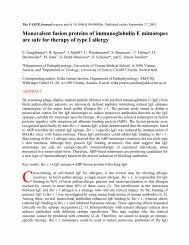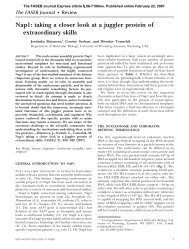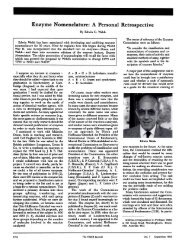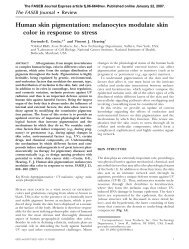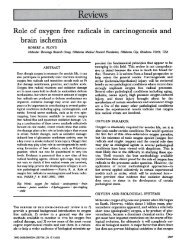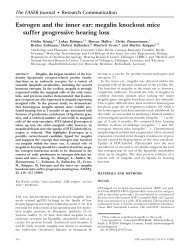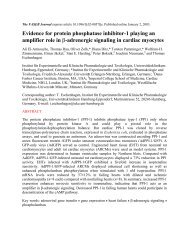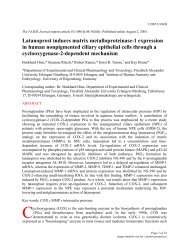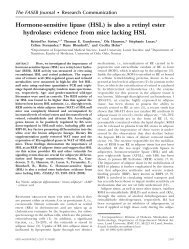Sense and Antisense in Biotech: The First Antisense DNA Company
Sense and Antisense in Biotech: The First Antisense DNA Company
Sense and Antisense in Biotech: The First Antisense DNA Company
You also want an ePaper? Increase the reach of your titles
YUMPU automatically turns print PDFs into web optimized ePapers that Google loves.
added to the cell culture medium, also <strong>in</strong>hibited the<br />
replication of Rous sarcoma virus (RSV) <strong>in</strong> <strong>in</strong>tact<br />
cells (3). Zamecnik tried to conv<strong>in</strong>ce Mass General to<br />
seek patent protection, but the <strong>in</strong>stitution deferred.<br />
Presumably, the rights then went to him, but he did<br />
not pursue them with the U.S. Patent <strong>and</strong> Trademark<br />
Office as far as we know. Meanwhile, 1 year before—<strong>in</strong><br />
1977—another key event had occurred.<br />
Zamecnik turned 65 <strong>and</strong> thus, came up aga<strong>in</strong>st the<br />
Harvard Medical School’s strict retirement policy. In<br />
an impassioned letter to the dean, Zamecnik made a<br />
case for side-stepp<strong>in</strong>g the retirement rule, but the<br />
adm<strong>in</strong>istration held to the policy. In one of the most<br />
ironic <strong>and</strong> fasc<strong>in</strong>at<strong>in</strong>g twists <strong>in</strong> this story, Zamecnik<br />
actually had the f<strong>in</strong>al satisfaction, 20 years later, as we<br />
shall see.<br />
Reaction to the two papers by Zamecnik <strong>and</strong> Stephenson<br />
was mixed. At this time, I was at the Worcester<br />
Foundation, a research <strong>in</strong>stitute <strong>in</strong> Shrewsbury, MA,<br />
<strong>and</strong> had <strong>in</strong> those years gotten to meet Zamecnik on<br />
several occasions, as he was on the foundation’s Board<br />
of Trustees. A few months after his 1978 papers came<br />
out, I went to see him to encourage the use of <strong>in</strong> vivo<br />
psoralen-mediated <strong>DNA</strong>-RNA cross-l<strong>in</strong>k<strong>in</strong>g to capture<br />
his oligo <strong>in</strong> its base-pair<strong>in</strong>g to the target RSV RNA. My<br />
lab was us<strong>in</strong>g this approach for other purposes at the<br />
time (4), <strong>and</strong> I was reasonably optimistic that the<br />
method could detect the base-pair<strong>in</strong>g of his oligo with<br />
its RNA target, <strong>and</strong> this would thus be an <strong>in</strong> vivo<br />
confirmation of the envisioned event. I thought this<br />
experiment could overcome the legions of skeptics at<br />
the time. So, on the morn<strong>in</strong>g of our scheduled meet<strong>in</strong>g,<br />
I w<strong>and</strong>ered <strong>in</strong>to Mass General th<strong>in</strong>k<strong>in</strong>g of all the<br />
great medic<strong>in</strong>e <strong>and</strong> medical science that had been<br />
done under its roof <strong>and</strong> began to th<strong>in</strong>k, “What am I<br />
do<strong>in</strong>g here?” (My angst was ma<strong>in</strong>ly because I had never<br />
studied medic<strong>in</strong>e, <strong>and</strong> I felt an imposter <strong>in</strong> such<br />
hallowed halls.) I found Zamecnik’s location, <strong>and</strong> we<br />
sat down at a battleship gray desk <strong>in</strong> a dusky hallway,<br />
leav<strong>in</strong>g me to ponder if this was <strong>in</strong> fact the office of the<br />
Collis P. Hunt<strong>in</strong>gton professor of Harvard Medical<br />
School? (It may not have been his real office but simply<br />
a convenient place for us to sit down, yet it may have<br />
been a prescient sett<strong>in</strong>g, for I later learned that he<br />
never sought adornments or embellishments <strong>in</strong> his<br />
office.) He clearly understood the psoralen cross-l<strong>in</strong>k<strong>in</strong>g<br />
idea, but he cordially deferred do<strong>in</strong>g the experiment,<br />
say<strong>in</strong>g that his group had too many other th<strong>in</strong>gs<br />
underway at the time. As I left for the elevator, I had a<br />
sudden realization: he wasn’t worried that he was<br />
wrong! This attribute (extreme confidence but not<br />
arrogance) has often been noted by historians of<br />
science when decipher<strong>in</strong>g the sheer determ<strong>in</strong>ation of<br />
visionaries. <strong>The</strong> late Judah Folkman once wrote that<br />
this trait, i.e., be<strong>in</strong>g sure (or at least 95% sure) at the<br />
outset, can pa<strong>in</strong>t one’s subsequent pursuit of the idea as<br />
either admirable persistence or bulldog obst<strong>in</strong>acy, depend<strong>in</strong>g<br />
on the lens of the observer (5).<br />
SENSE AND ANTISENSE IN BIOTECH<br />
cis/trans AT THE NIH<br />
Zamecnik <strong>and</strong> his group had played a sem<strong>in</strong>al role <strong>in</strong><br />
open<strong>in</strong>g up the entire field of molecular biology by<br />
ref<strong>in</strong><strong>in</strong>g cell-free prote<strong>in</strong> synthesis <strong>and</strong> discover<strong>in</strong>g<br />
am<strong>in</strong>o acid activation <strong>and</strong> transfer RNA (1). Now, 20<br />
years later, he had made yet another major discovery—<br />
the first embodiment of antisense <strong>DNA</strong>—<strong>and</strong> so, he was<br />
underst<strong>and</strong>ably dispirited by the retirement policy of<br />
his <strong>in</strong>stitution, one to which he had given so much time<br />
over the years on numerous committees (notably, Mass<br />
General’s Executive Committee, which he once told<br />
consumed one-third of his time) <strong>and</strong> other substantial<br />
roles beyond his own laboratory. He promptly sought<br />
<strong>and</strong> received a Fogarty Fellowship to spend 1 year at<br />
NIH, dur<strong>in</strong>g which he pondered his options. At 65,<br />
Zamecnik was still physically robust <strong>and</strong> as athletically<br />
<strong>in</strong>cl<strong>in</strong>ed as always, so he looked around the NIH<br />
campus for potential tennis partners. He later told me<br />
that he <strong>and</strong> several NIH scientists had jo<strong>in</strong>tly <strong>and</strong><br />
amicably “<strong>in</strong>terviewed each other at the net” (a sort of<br />
cis-trans test, to use the genetics metaphor). After a few<br />
games <strong>in</strong> trans, Zamecnik <strong>and</strong> one partner became cis.<br />
<strong>The</strong> mutually chosen partner was Robert Gallo. This<br />
conjunction turned out to be a profound event.<br />
CALLING HOME<br />
As his NIH Fogarty year was draw<strong>in</strong>g to a close, Zamecnik<br />
wrote to his former post doc Mahlon Hoagl<strong>and</strong>,<br />
who had discovered transfer RNA <strong>in</strong> 1958 when work<strong>in</strong>g<br />
<strong>in</strong> Zamecnik’s group. Hoagl<strong>and</strong> was now president<br />
of the Worcester Foundation for Experimental Biology<br />
<strong>and</strong> was well along <strong>in</strong> redirect<strong>in</strong>g the <strong>in</strong>stitution from its<br />
orig<strong>in</strong>al fame <strong>in</strong> endocr<strong>in</strong>e <strong>and</strong> reproductive biology—<br />
hav<strong>in</strong>g played a key role <strong>in</strong> both the birth control pill<br />
<strong>and</strong> <strong>in</strong> vitro fertilization—<strong>in</strong>to molecular biology <strong>and</strong><br />
cancer research. In this curious reversal of their previous<br />
roles, Zamecnik was now ask<strong>in</strong>g his former post doc<br />
to take him <strong>in</strong>.<br />
<strong>The</strong> antisense <strong>DNA</strong> research program that Zamecnik<br />
wrote up was seen by everyone with whom Hoagl<strong>and</strong><br />
consulted (<strong>in</strong>clud<strong>in</strong>g myself) as powerfully promis<strong>in</strong>g,<br />
<strong>and</strong> he was enthusiastically <strong>in</strong>vited to come. (<strong>The</strong><br />
write-up Zamecnik had prepared had, at the top, a<br />
phrase <strong>in</strong> his h<strong>and</strong>writ<strong>in</strong>g that I have always remembered:<br />
“Dear Mahlon, Of course, this reads like a<br />
novel”.) Zamecnik’s pioneer<strong>in</strong>g work on prote<strong>in</strong> synthesis<br />
at Mass General had been funded by a longst<strong>and</strong><strong>in</strong>g<br />
grant from the Atomic Energy Commission, <strong>and</strong> on<br />
his arrival at the Worcester Foundation, a very softmoney<br />
<strong>in</strong>stitution, the issue arose as to how he <strong>and</strong>/or<br />
the <strong>in</strong>stitution would now fund his promis<strong>in</strong>g ideas<br />
about antisense <strong>DNA</strong>. He soon obta<strong>in</strong>ed a grant from<br />
the National Institute of General Medical Sciences, <strong>and</strong><br />
his lab was also supported <strong>in</strong> part by a National Cancer<br />
Institute (NCI) “Core” grant that Hoagl<strong>and</strong> had won <strong>in</strong><br />
1971 <strong>and</strong> that I had successfully renewed as thendirector<br />
of our Cancer Center. Later, after I succeeded<br />
3595



